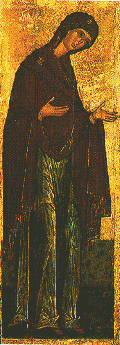

You cannot understand the Russian soul
without knowing the Russian icon.
In old Russia the icon was
the commonest form of figurative art.
It was a visual demonstration
of faith in love and charity,
the triumph of justice
and the victory of Good over Evil.
The icon was an ever - present companion -
at home, in church, on journeys and at war.
Novgorod Icon Gallery will help you
to discover the complex and many-sided world
of the old Russians icon,
and to recognise the links
between Russia's past and her present.
At the end of the X century, when Christianity was adopted as the official religion of Kievan Rus', Novgorod had already ranked among the largest Slav cities. In the pre - Mongolian times, the elder sons of Kievan dukes ruled in Novgorod and they took their service on the north - western borders of Russia as a training before their return to Kiev to succeed their fathers. The names of these princes are connected with the first period of the church construction in Novgorod. Some grandiose cathedrals and churches were erected: the Cathedral of St. Sophia (1045-1050), the Nikolo-Dvorishchensky Cathedral (1113), and the Cathedral of St. George in the Yuriev Monastery (1119). The splendid interiors of the Cathedrals harmonized with their magnificent architecture.
The economic and social development of Russia proceeded in such a way that in the XII century the foundation was laid for the establishment of the Novgorod feudal republic. The Prince exercised the executive and judicial power and was the supreme commander, but the real power in the city and in the vast Novgorodian land - from the White Sea to the upper Volga and from Russia's western borders to the Urals - gradually passed to the mighty Novgorodian boyars: these "best men" of Novgorod, as they are called in chronicles, had the final say in the veche, the popular assembly. The boyars were fabulously rich, and they were generous patrons of arts and crafts. They built churches and spent their honey on wall paintings, embroidery, and jewelled church plate. The civil construction also benefited by the boyars' patronage: the handsome mansions and public buildings were erected in Novgorod, lending the city its inimitable beauty.
The landlords of non - aristocratic origin (zhitji lyudi) highly appreciated works of art, just as and the Novgorod's enterprising merchants who turned their city into a world famous trade centre. Novgorod occupies an advantageous position at the junction of waterways and land routes. Goods from all over the world were shipped to Novgorod. Naturally enough, the local craftsmen absorbed the traditions of many nations of the East and West.
The clergymen of Novgorod had made their contribution to the city's prosperity. Big and small monasteries (the Yuriev, the Antoniev and the Khutinsky monasteries were the oldest among them) stood dense around the city. Besides religion, the monasteries were engaged in economic and cultural activities. Vladyka (lord), the Archbishop of the Novgorod Church, played an important part in the political life of the city. The Archbishop had control over the estate of the House of St. Sophia which brought a considerable income. The Archbishops of Novgorod used their money on important cultural projects: the book and chronicle writing, the construction of churches and fortifications, the founding of new monasteries and the bell casting. Their artists and craftsmen created the outstanding works of art.
All sections of the population had a vast scope of application for their talents in this rich free city bursting with life, active in politics and cultivating crafts and trade. Common people, most of whom were artisans, modernized their city; they cobbled streets, laid drain pipes, built houses and laid out gardens. The builders, the fresco and icon painters, the silversmiths, the stone, hone and wood carvers were mostly the natives of Novgorod. Those who distinguished themselves in their crafts were commissioned to work in the shops of the Prince, the Archbishop and the monasteries. Some of them were invited to work in other cities, and the Novgorodian masters were among the builders and decorators of the new Russian capital, Moscow.
In the XIV - XV centuries Moscow dukes took great effort to raise the new capital. Acquiring the status of grand dukes, they strove to overcome the dissociation of Russian lands and pursued the policy of uniting apanage principalities and feudal republics into a single state. Novgorod was joined to Moscow, and the Novgorod republic ruled by the veche fell in 1478 - this was the main result of the Moscow dukes' policy and determined its success.
The loss of the political independence by Novgorod caused serious changes in its social structure but did not entail an economic or cultural decline. Until the middle of XVI century Novgorod continued to be the second in importance city in Russia; its creative potential was instrumental in developing a new national Russian style in architecture and painting.
The hard times of devastation were to come later. The raids of the oprichniki, the soldiers of Ivan the Terrible, and the long Livonian War rendered Russia lifeless, and greatly affected Novgorod. A revival of economy and enlivening of culture in the late XVI and early XVII centuries were followed by the retrogressions in the Troubled Time. The Novgorodians were leaving their city that was occupied by the Swedes from 1611 to 1617 yy. The restoration work begun in the 1620s could not give the city back its former splendour, but still prevented it from turning into a remote downgraded provincial town. The centuries - old traditions, the magnificent heritage of the past helped to preserve the inimitable beauty of this Russian city and were the source of pride and inspiration for the generations to come.